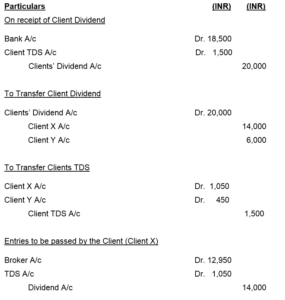In the earlier tax regime, after corporate tax of 25% to 30% (effectively 33.99% including surcharge and cess), the Company was also liable to pay Dividend Distribution Tax (commonly known as DDT) to the tune of 20.56% (after grossing up) while distributing the same profit to its shareholders or investors while the dividend received was exempt in the hands of the shareholders.
In Union Budget 2020, the Honorable Finance Minister Nirmala Sitharaman abolished the Dividend Distribution Tax (commonly known as DDT) and correspondingly made the dividend taxable in the hands of individual shareholders and as a result of the same w.e.f. April 1, 2020, Companies would also be required to withhold taxes at the prescribed rates on dividend paid to its shareholders, depending on their residential status and the documents submitted by them and accepted by the Company.
What is TDS on Dividend Income?
The irony is explained by the fact that, while some categories of equity investors will get the benefit of lower taxes on their dividend income after the DDT abolition, others will end up paying through their nose.
Those super rich residential individuals and trusts who fall under the highest slab of 30% with income more than Rs. 5 crore will have an effective tax rate of 35.88% (including surcharge and cess) and would be the biggest losers in the proposed DDT regime.
Hence, out of Rs. 100/- earned by the company, Rs. 57.67/- is collectively taken by the government as corporate tax and individual income tax which is very high and results into double taxation and the surplus that remains in the hands of the business person is only Rs. 42.33/-.
The dividend received on equity shares and mutual funds which were earlier exempt is now taxable in the hands of investors / shareholders.
Further, the government has proposed deduction of TDS on dividend Income distribution as per Section 194 which seems unnecessary as most of the dividend is now directly credited in the bank account of the shareholder through banking channel (ECS) and hence there was no need for that mechanism to check tax erosion. This provision is resulting into another jeopardy as discussed below:
TDS Rate on Dividend Income paid to Resident Shareholders:
| Particulars | Applicable Rate | Documents required
(if any) |
| With PAN | 7.5%* | Update the PAN, if not done |
| Without PAN/Invalid PAN | 20% | – |
*A TDS of 10% applies to the dividend income distribution per investor. For FY 2020-21, the rate of TDS stands reduced to 7.5% for dividends paid till 31 March 2021.
TDS on Dividend Income and its impact on Shares lying in Broker Member’s Pool Account:
Due to this amendment, a practical difficulty is being raised for share brokers with regard to shares of their clients lying in their Pool Account on the record date of dividend.
Therefore, the brokers receive dividends on behalf of their clients whose shares currently lie in the Pool Account and pursuant to above amendment, TDS deducted by the Companies declaring dividend will also start appearing in 26AS statement of the Brokers although this dividend does not belong to the Broker.
Let’s take a hypothetical situation where a share broker receives dividend (against shares lying in the pool account) of Rs.20,000/- pertaining to two clients – Mr. X Rs. 14,000/- and Mr. Y Rs. 6,000/-.
Following entries need to be passed in books of accounts by the broker:
So, while filing Income tax return share brokers need to ensure that credit for TDS on clients’ dividend appearing in their Form 26AS is not claimed by them, otherwise the said dividend might be treated as their income which may cause adjustments in their taxable income. Clients get their TDS credit although not appearing in their own Form 26AS.
Therefore, it is imperative that brokers keep ready details of their clients’ TDS in such format from the starting so that there are no issues at the time of filing returns from AY 2021-22 onwards.
In legitimate situation as described above, when the shares lying in Broker Member’s Pool Account on the record date of dividend, although the TDS would be deducted, it is very likely that the shareholders would not be able to claim the credit as same would not be reflected in their Form 26AS and hence naturally the processing of return of income u/s. 143(1) by the CPC would result into tax demand along with interest giving rise to unnecessary hardship and tax burden on such shareholders.
Considering this, the surplus in the hands of shareholders would be only Rs. 35.73/- (i.e. Rs. 42.33/- (less) Rs. 6.60/- TDS as stated above).
Therefore, it is high time that the Ministry of Finance takes a apt policy decision so that the tax payer does not end up paying tax twice or thrice on the same profit. A flat rate of tax on dividend at the rate of 10% and scraping of Section 194 would be a wise decision if India really wants to attract investments and wish to encourage local entrepreneurs.
Related:
